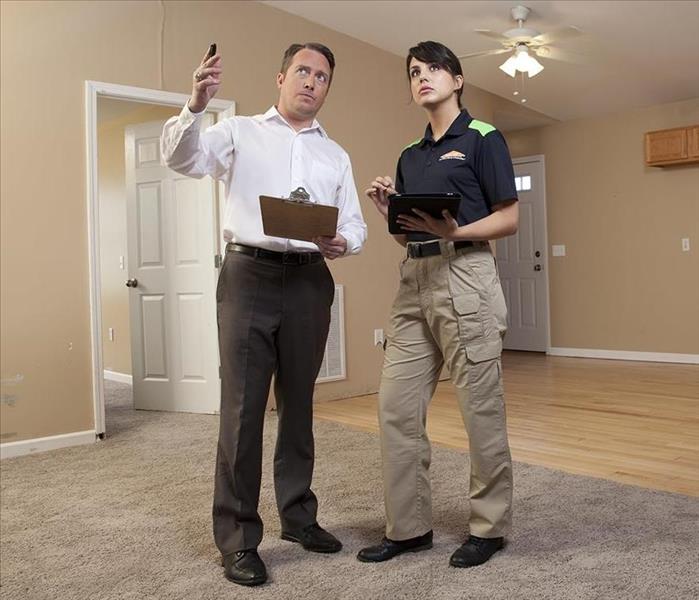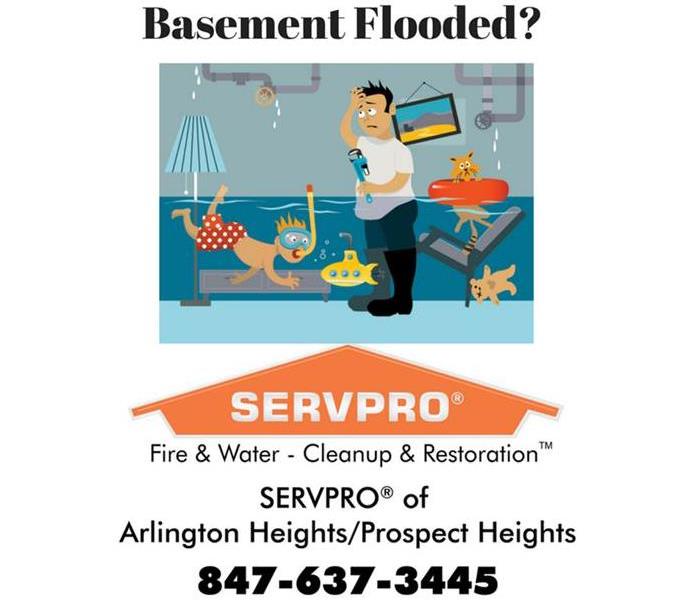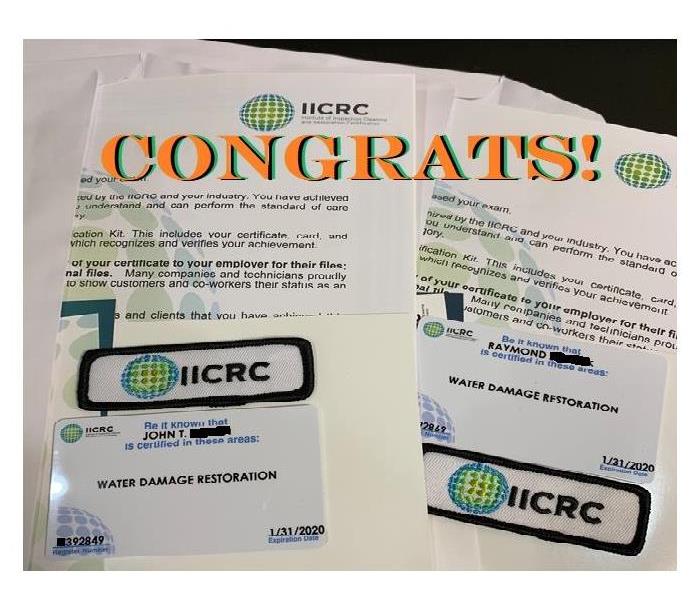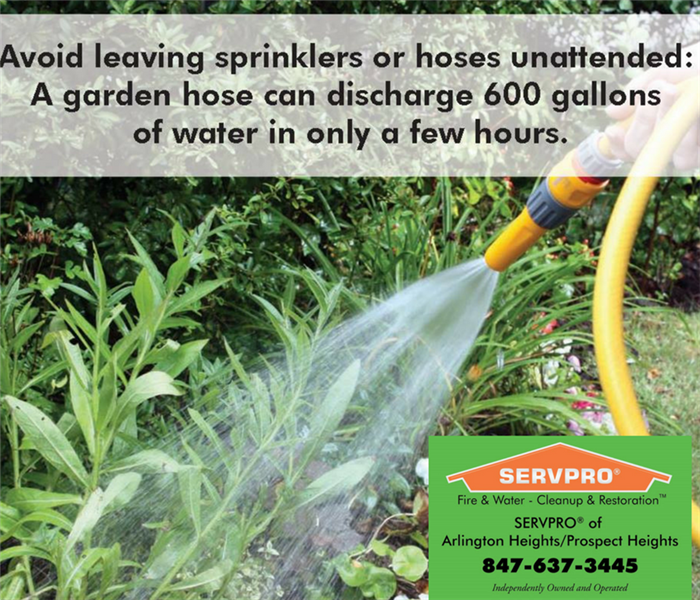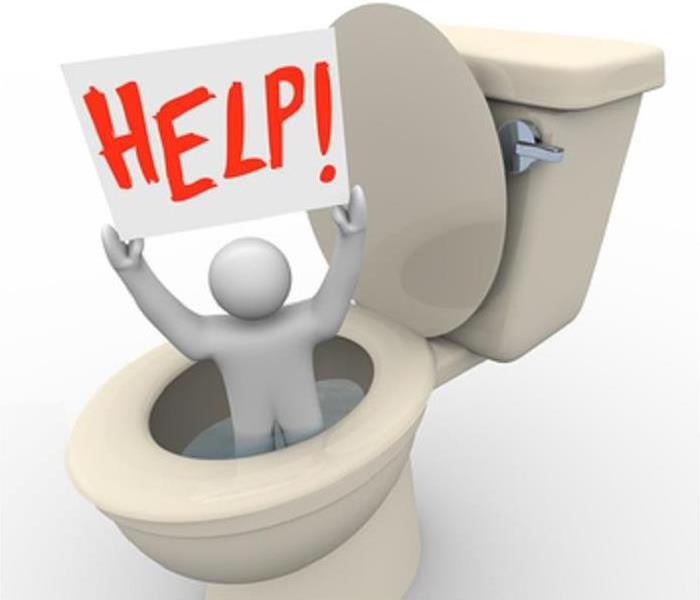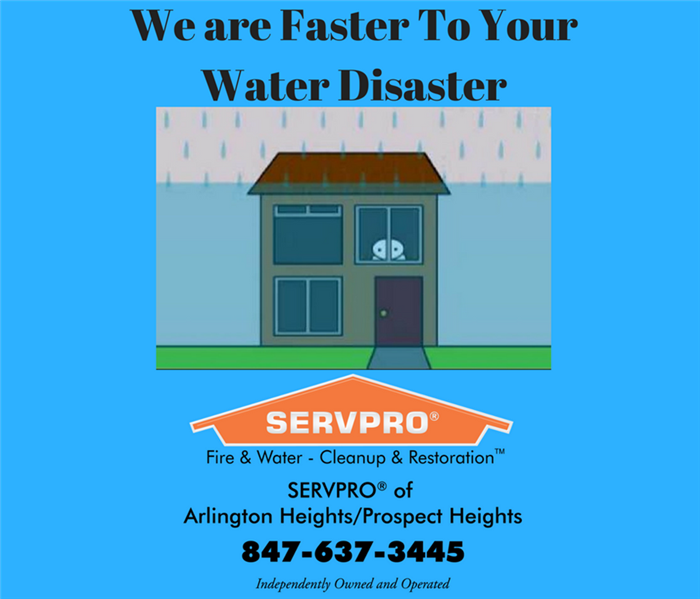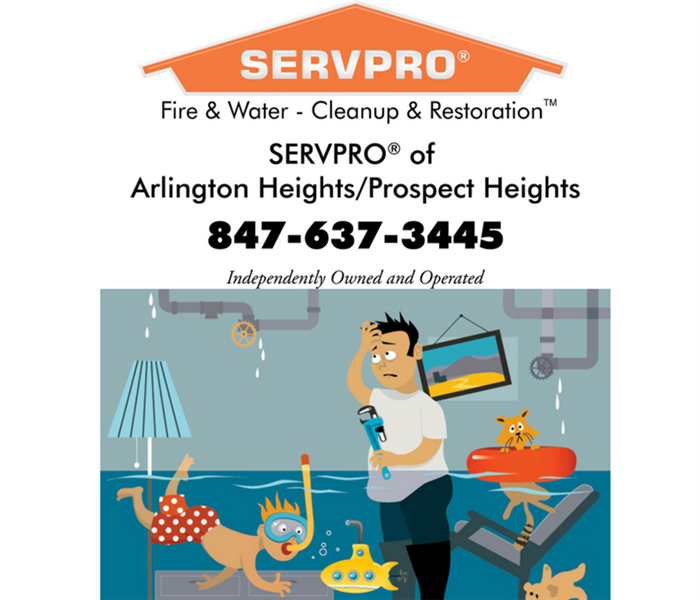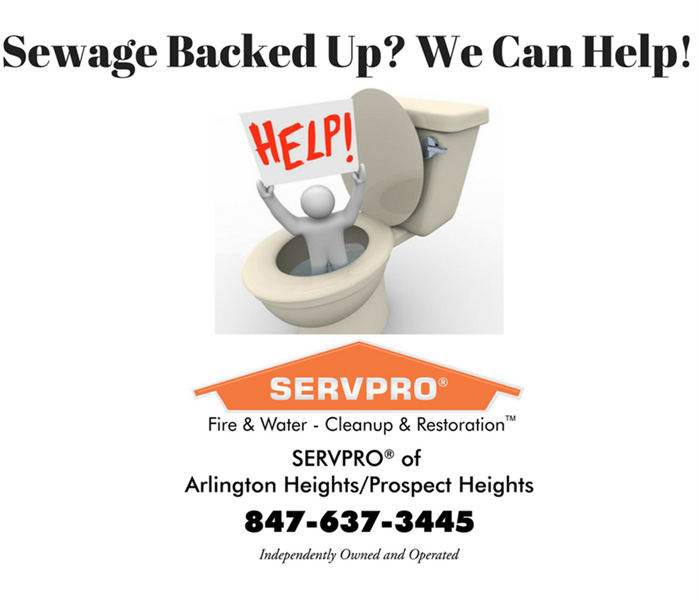Recent Water Damage Posts
Frequently Asked Questions About Water Damage
11/6/2024 (Permalink)
Common Questions Regarding Water Damage: SERVPRO's Perspective
Water damage can happen without warning, leaving both business and home owners perplexed and upset. For efficient management and restoration, it is essential to comprehend the subtleties of water damage, its causes, and its remedies. To assist you in navigating this complicated matter, SERVPRO®, a top supplier of disaster recovery and restoration services, has put together a list of frequently asked questions. This is what you should know.
1. What are the typical reasons why water damage occurs?
Numerous factors can lead to water damage, such as:
- Natural catastrophes: Significant water intrusion can result from hurricanes, flooding, and heavy rains.
- Plumbing Issues: Burst pipes, overflowing toilets, and leaky faucets are prevalent culprits of water damage.
- Appliance Failures: Malfunctioning appliances, such as washing machines, dishwashers, and water heaters, can cause extensive damage.
- Roof Leaks: Damaged or missing shingles can allow rainwater to penetrate your home.
- Humidity: High humidity levels can lead to mold growth and damage, especially in basements and crawlspaces.
2. What are the signs of water damage?
Water damage symptoms might not always be obvious at first glance. The following are some warning signs to watch out for:
Water Stains: Discolorations on floors, walls, or ceilings may indicate the presence of water intrusion.
Mold Growth: Moisture issues are indicated by a musty smell or visible mold.
Paint that is peeling or bubbling may indicate that water is trapped beneath the surface.
Warped Floors: Sagging or buckling floors are frequently an indication of water damage.
Higher Water Bills: An unexpected increase could be a sign of a concealed leak.
3. What should I do if I discover water damage?
Immediate action is essential to prevent further damage:
- Shut Off Water Supply: If the source of the water is a plumbing issue, turn off the water supply to minimize damage.
- Remove Valuables: Safeguard personal items, furniture, and electronics by moving them to a dry area.
- Document the Damage: Take photos for insurance purposes.
- Contact Professionals: Reach out to SERVPRO or a similar restoration service to assess and remediate the damage.
4. How does SERVPRO handle water damage restoration?
SERVPRO follows a systematic approach to water damage restoration:
- Assessment: Technicians will evaluate the extent of the damage and develop a comprehensive restoration plan.
- Water Extraction: Advanced equipment is used to remove standing water quickly.
- Drying and Dehumidification: High-velocity fans and dehumidifiers are deployed to dry out affected areas.
- Cleaning and Sanitizing: All surfaces are cleaned and sanitized to prevent mold growth and odors.
- Restoration: Damaged materials are repaired or replaced, returning your property to its pre-damage condition.
Conclusion
Water damage can be overwhelming, but with knowledge and timely action, you can effectively manage the situation. SERVPRO is here to assist you in restoring your property and providing peace of mind. Familiarize yourself with these frequently asked questions, and don’t hesitate to reach out for professional help when needed. Remember, prevention is key, so stay proactive in safeguarding your home or business from potential water damage.
Spring Thaw: Identifying Burst Pipes, Water Damage, and Mold Growth
3/19/2024 (Permalink)
As the winter frost gradually gives way to warmer temperatures, it's essential to remain vigilant and keep an eye out for potential problems that may arise during the transition. One such concern is the discovery of burst pipes and the subsequent water damage or mold growth that may occur. In this blog, we will explore the effects of warming conditions on your plumbing system, how to identify burst pipes, and the necessary steps to prevent water damage and mold growth.
The Impact of Warming Conditions: As the weather warms up, the frozen water within your pipes begins to thaw. This transition can put stress on your plumbing system, potentially leading to burst pipes. Additionally, the increased moisture and humidity levels resulting from melting snow can create an ideal environment for mold growth. It's crucial to be proactive and address these issues promptly to mitigate further damage.
Identifying Burst Pipes:
Water Leaks: Keep an eye out for any signs of water leaks, such as water stains on the walls or ceiling, damp spots on the floor, or a sudden increase in your water bill.
Reduced Water Pressure: If you notice a significant decrease in water pressure throughout your home, it may indicate a burst pipe.
Unusual Sounds: Pay attention to any unusual sounds coming from your plumbing system, such as hissing or gurgling noises, which could indicate a ruptured pipe.
Wet or Bulging Walls: If you notice wet patches or bulging areas on your walls, it may be a sign of hidden water damage caused by a burst pipe.
Preventing Water Damage and Mold Growth:
Inspect Your Plumbing System: Regularly inspect your pipes, especially in vulnerable areas such as basements, crawl spaces, and attics. Look for any signs of corrosion, cracks, or leaks.
Maintain Proper Insulation: Ensure that your pipes are adequately insulated, particularly in areas exposed to colder temperatures. This will help prevent them from freezing and potentially bursting.
Monitor Humidity Levels: Use a hygrometer to monitor the humidity levels in your home. Aim for a relative humidity of around 30-50% to discourage mold growth.
Promptly Address Leaks: If you notice any water leaks, address them immediately. Repairing leaks promptly can prevent further damage and minimize the risk of mold growth.
Seek Professional Assistance: If you suspect a burst pipe or water damage, don't hesitate to contact a professional restoration company like SERVPRO. Their expertise and specialized equipment can help identify the extent of the damage and provide effective solutions.
Conclusion: As the winter chill fades away, it's crucial to remain vigilant and address any potential issues related to burst pipes, water damage, and mold growth. By staying proactive, regularly inspecting your plumbing system, and promptly addressing any leaks or signs of damage, you can protect your home from the costly and disruptive consequences of burst pipes. Remember, early detection and professional assistance are key to minimizing the impact of water damage and mold growth. Stay ahead of the spring thaw and keep your home safe and dry!
Please note that this blog is for illustrative purposes only and does not substitute professional advice. If you encounter any issues with burst pipes, water damage, or mold growth, it's recommended to consult with a qualified professional.
How Long Does Water Damage Restoration Take?
3/7/2024 (Permalink)
Timelines for restoring water damage might vary based on a number of variables. The length of the restoration depends on a number of factors, including the type of water damage, the size of the affected area, the extent of the damage, and the materials utilized in the process. Although the drying time cannot be precisely predicted, the following general principles can be used:
1. First Evaluation and Water Removal: The assessment of the damage and removal of any standing water constitute the initial steps in the repair procedure. Usually, this takes place in the first few days following the incident.
2. Process of Drying: Following the extraction of water, the drying process starts. The damaged areas typically require 2 or more days to completely dry. However, a number of variables, like the size of the house, the materials impacted, and the extent of the damage, might determine how long it takes for the materials to dry. It's crucial to remember that if there is significant water damage or if the water has been permitted to soak for a long time, the drying process could take longer.
3. Remedial Mold: More time might be needed for mold treatment if mold growth is found. In a damp atmosphere, mold can begin to grow in as little as 24 to 48 hours, so it's critical to take quick action to stop more damage and health hazards.
4. Rebuilding and Repairing: The restoration and reconstruction procedure can start as soon as the impacted regions are dry and mold-free. This include fixing or swapping out worn-out components like paint, flooring, and drywall. Depending on the degree of damage and the difficulty of the restoration effort, this phase's time may change. Restoration of water damage can take weeks on average, but in more extreme circumstances, it might take longer.
It's crucial to remember that these schedules are only estimations and may change based on the particulars of each water damage situation. The length of the restoration process can also be affected by unanticipated events, insurance procedures, and the availability of restoration specialists.
To ensure a smooth and efficient restoration process, it is recommended to contact a professional water damage restoration company as soon as possible. They have the expertise, equipment, and experience to assess the damage, extract water, dry the affected areas, and restore your property to its pre-damage condition.
Remember, the sooner you address water damage and initiate the restoration process, the better chance you have of minimizing further damage and reducing the overall restoration time.
Understanding Water Damage and Navigating Insurance Claims
11/3/2023 (Permalink)
Water damage can be a devastating event for homeowners, causing significant financial and emotional stress. Whether it's a burst pipe, a leaky roof, or flooding, the aftermath of water damage requires swift action to mitigate further damage and restore your property. In this article, we will explore the importance of homeowners insurance coverage for water damage, the process of submitting a claim, and how SERVPRO® can assist you in the restoration process.
- Understanding Homeowners Insurance Coverage for Water Damage:
Homeowners insurance policies typically cover sudden and accidental water damage caused by events such as burst pipes, appliance malfunctions, or storms. However, coverage may vary depending on the policy and the cause of the water damage. It's crucial to review your policy to understand the specific coverage and exclusions related to water damage.
References:
- Submitting a Water Damage Insurance Claim:
When faced with water damage, it's essential to act quickly and follow the necessary steps to submit an insurance claim. Here are the general steps involved:
a) Document the Damage: Take photos or videos of the affected areas, including any damaged belongings. This visual evidence will help support your insurance claim.
b) Contact Your Insurance Provider: Notify your insurance company as soon as possible to report the water damage. They will guide you through the claims process and provide the necessary forms and information.
c) Provide Detailed Information: Fill out the claim form accurately, including all relevant details about the incident, such as the cause of the water damage, the extent of the damage, and any temporary repairs made to prevent further harm.
d) Engage Professional Help: Contact a reputable water damage restoration company like SERVPRO to assess the damage and provide an estimate for repairs. Their expertise and experience can help ensure the restoration process is handled efficiently and effectively.
References:
- How SERVPRO Can Help:
After experiencing water damage, engaging the services of a professional restoration company like SERVPRO can make the recovery process smoother and more efficient. Here's how SERVPRO can assist you:
a) Immediate Response: SERVPRO understands the urgency of water damage situations and provides 24/7 emergency response. Their quick arrival can help prevent further damage and ensure a prompt restoration process.
b) Comprehensive Assessment and Restoration: SERVPRO's highly trained technicians will conduct a thorough inspection of the affected areas to identify hidden damage. They will develop a customized restoration plan and utilize advanced equipment to extract water, dry the structure, and restore your property to its pre-damage condition.
c) Insurance Coordination: SERVPRO works closely with insurance companies and can assist you in navigating the claims process. Their expertise in dealing with insurance providers helps streamline the process and ensure a smoother claims settlement.
References:
Conclusion:
Water damage can be a distressing experience for homeowners, but having the right insurance coverage and understanding the claims process can alleviate some of the burdens. By promptly reporting the damage, providing detailed information, and engaging the services of a reputable restoration company like SERVPRO, you can expedite the recovery process and restore your home to its former glory.
Remember to review your homeowners insurance policy regularly to ensure you have adequate coverage for water damage and consult with professionals for expert advice and assistance.
National Tune-Up Day
9/23/2022 (Permalink)
September 25th is National Tune-up Day. National Tune-up Day was created to remind homeowners to prepare their house for winter. In preparation for the changing seasons heating and cooling specialists recommend tuning up heating systems before the temperature drops.
During the spring and summer months the ability to open your windows and allow your home to breathe. Spring and summer are prime for the growth of flowers, summer nights at the beach taking in the fresh air and playing with your pets in the backyard or grilling up a steak. Spring and summer are also primal months for the spread of mold growth, pollen and other air traveling particles such as pet fur and dust via your home's air flow system. This can congest your home's ventilation system.
If your homes ventilation system seems a bit slower this may be the cause. Are you pondering what mechanics actually tune-up? Well according to “National Today” almost all your home's systems require regular maintenance. For instance, combustion gases should be examined and contrasted with the furnace's requirements. To ensure that the furnace's blower access door has a tight seal, it must be examined. Checking the fresh air intake grills for obstruction and the burners for good ignition and flame are two further inspections that are required. The repairman examines the furnace and checks for leaks and blockages in the drainage system. Traps, taps, and drains must all be tested as well. Additionally, some mechanics might advise checking the blower wheel, motor, wiring, and all filters. Additionally, the elements should be examined for deterioration and damage. A tune-up for your heating system helps you save energy and cut heating costs. Additionally, these tune-ups guarantee that the system will function optimally for the specified number of years.
SERVPRO Arlington Height/Prospect Heights has been specializing in the cleanup and restoration of residential and commercial property after fire, smoke, and water damage disasters for a very long time. Our staff is highly trained in property damage restoration, and we are an IICRC Certified Firm. We believe in continuous training: from initial and ongoing training at SERVPRO’s corporate training facility to regular IICRC-industry certification. Rest assured our staff is equipped with the knowledge to restore your property. Our continuing education programs also give us the ability to connect with insurance agents, adjusters, and more. This lessens the gap in the work processes for SERVPRO and insurance.
The Basement Flood Experts
7/26/2022 (Permalink)
Although flooding most often occurs during heavy rainfall, a basement can flood at any time. Basements are inherently prone to flooding simply because they are the lowest level of a building and are normally built partly or entirely below ground level. There are a number of reasons why your basement could flood, including:
- A blocked or failed sewer lateral pipe
- Heavy rain causes surface water to pool around your home
- Storm sewer backup
- Sanitary sewer backup
- A failing Sump pump
- Foundation drainage failure
- Water supply-line break or hot-water tank failure
- And many more
Do You Have Questions about Basement Flooding?
Call SERVPRO of Arlington Heights Today
If flood water is not handled quickly and properly, it can jeopardize your health and safety, or even cause severe damage to your home’s structure. Remember, the longer you wait, more likely the more damaging effects are happening.
The bottom line: a flooded basement can jeopardize your safety, and your home’s integrity. It’s worth making a call to SERVPRO of Elmhurst and letting our trained, professional crews handle the situation safely and correctly. We have earned the trust of hundreds of homeowners, business owners, and property professionals.
We are Flooded Basement Specialists:
- We are Available 24 hours/7 days per week
- We’re a Preferred Vendor to many National Insurance Companies
- We Bill The Insurance Directly – One Less Thing For You To Worry About
- Our Technicians are Highly-Trained in Water Restoration Techniques
- We use s500 IICRC Restoration Standards
- Advanced Inspection and Extraction Equipment
Basement Flooded? Call Us Today 847-637-3445 – SERVPRO of Arlington Heights is Ready To Help!
9 Ways to Keep Your Home Safe From Water Damage
3/13/2022 (Permalink)
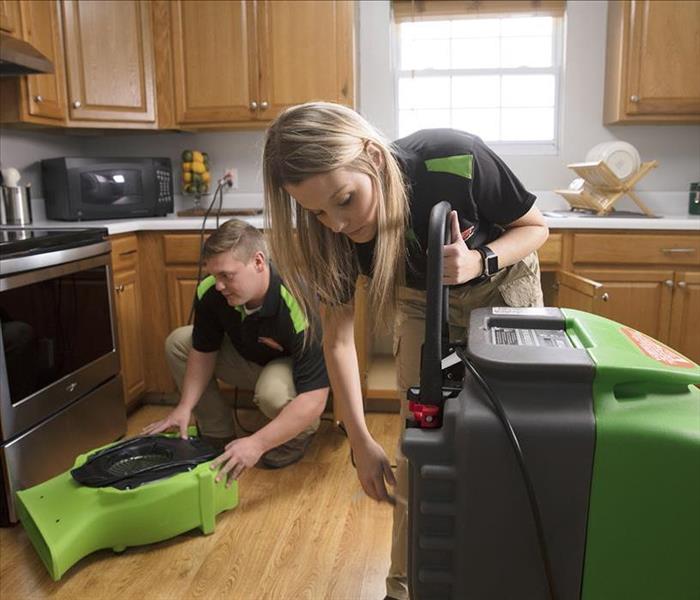 Minor leaks can go undetected for a long time and cause significant damage if left unchecked.
Minor leaks can go undetected for a long time and cause significant damage if left unchecked.
- You should be aware of the location of the stopcock. Ensure that not only you but also your family members are aware of its location. A severe leak or rupture can cause significant damage in minutes. It is critical to understand where and how to turn off the water supply.
- Check for leaks ahead of time. Minor leaks can go undetected for a long time and cause significant damage if left unchecked. Consider that a dripping faucet can waste up to 57 gallons of water per week. Look for signs of stray water beneath sinks and around appliances such as dishwashers and washing machines.
- Check that your sump pump is operational. The sump pump, which is common in basement homes, plays an important role in ensuring that your basement does not flood after prolonged periods of rain. If you have one, make sure it's well-maintained and serviced at least once a year.
- Keep debris out of your gutters. While leaves are the most common cause of blocked gutters, this isn't just an autumnal problem. Moss and weeds are frequently discovered to be a major cause. Blocked gutters play a significant role in damp problems. If you see water running down the side of your house or if your gutters appear to be sagging, they're probably blocked and need to be cleaned.
- Inspect your roof from the inside out. Examine the inside of your attic for signs of water leaking through the roof. Examine the joists for damp spots and the plaster for tea-colored stains. Outside, look for visible damage to the roof and make sure the flashing around any chimneys is in good condition.
- Keep your pipes from freezing. Even if you plan to be away, use a smart thermostat to keep your home at a minimum temperature of at least 10 degrees Celsius. Warm water must be able to circulate through pipes to avoid freezing damage. If a property will be unoccupied for an extended period of time, turn off the water supply at the stopcock and consider draining the system so that no water remains in the system.
- Pipes that are exposed should be properly insulated. Snap-on pipe insulation is inexpensive and effective, and it can also be used outside.
- Install a device to detect water leaks. Detection devices, which are relatively inexpensive, cut off the water supply in the event of a leak, which is critical if you leave your property vacant for extended periods of time.
- Look for any signs of moisture or mold. Damp can be detected by flaking paint or wallpaper, as well as black, speckled marks on skirting and sills. Consider adding more insulation if your walls feel cold to the touch or if you notice a musty odor. In the mornings, check windows and skylights for condensation. Its presence can indicate that your home has higher-than-average moisture levels.
How to Protect Your Property from Floods Caused by Snowmelt, Ice Jams, and Winter Storms
1/28/2022 (Permalink)
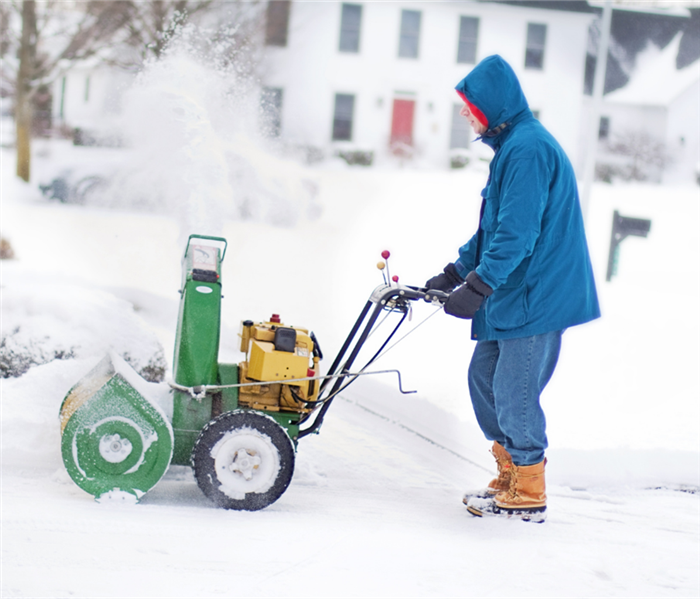 The risk of flooding doesn't go away in the winter.
The risk of flooding doesn't go away in the winter.
When we hear about flooding in the news, we usually hear about spring floods and summer storms, giving the impression that flooding occurs just half of the year. We're not out of the woods yet.
The risk of flooding doesn't go away in the winter, and flooding isn't the only thing to be concerned about when the weather turns cold. Snowmelt, ice jams, and winter storms threaten major floods from the Pacific Northwest to the Great Lakes to the Northeast throughout the winter months.
Winter Flood Risk #1: Snowmelt
Snowmelt is an element of the natural water cycle. However, if snow thaws too quickly to be absorbed back into the soil, neighboring water bodies, and drainage systems, it can flood adjoining land, potentially flooding your basement.
Snowmelt floods can occur anywhere in the snowy north of the US, and they usually occur in small, isolated episodes. But that doesn't rule out the possibility of serious consequences. Let's pretend it snows ten inches, which isn't unheard of in freezing areas. One inch of water equals ten inches of snow, and an inch of floodwater can cost you up to $25k in repairs, according to FEMA.
While snowmelt risk is higher in the spring, climate change has introduced more and more unseasonably warm temperatures every winter. Take the 2019 Midwestern floods, for example. Record amounts of snowfall from January through March were followed by a three-day stretch of 60-degree weather. Rain fell and caused historic levels of flooding along the Missouri River and its tributaries.
Winter Flood Risk #2: Ice Jams
Long cold episodes that cause the surface of rivers to freeze are followed by warm spells, resulting in ice jam floods. Large pieces of ice break off unevenly as temperatures rise, blocking streams and flooding adjacent settlements.
Winter Flood Risk #3: Winter Storms
People who live in lakeside places like the Windy City are probably familiar with flooding in the winter. Strong winds from winter storms can create massive waves that crash over shorelines and barriers into city streets, as they did in Chicago last winter.
These winter storms and subsequent floods are common in the Midwest along the Great Lakes, but they also happen along the East Coast. Nor’easters can trigger storm surges that push heavy ocean tides into coastal communities, on top of heavy rain or snow.
Regular downpours and flash floods can happen throughout the winter, too, as long as temperatures are high enough.
Steps You Can Take This Winter to Prevent Flooding on Your Property
The easiest method to protect your property from a flood is to put measures in place before one occurs. The two most important actions to take care of to ensure that you have both financial and structural flood mitigation on your property.
Step 1: Secure Flood Insurance
Purchase flood insurance as soon as possible once the fear of floods has passed. That way, if you experience flood damage this winter, you'll be able to file a claim swiftly and easily.
The good news is that a flood insurance policy covers all sorts of flood damage equally, so your policy will provide coverage all year. The cost of coverage is decided by factors such as the age of your structure, the type of foundation it has, and your flood zone and risk level.
Step 2: Shovel Proactively and Test Drainage Systems
Shovel snow away from your foundation by at least five feet.
Shovel snow away from a runoff path if your property is on a slope or hill.
Remove any snow that has accumulated on your roof.
Keep snow and ice from accumulating around your property's drainage systems, such as gutters and groundwater pumps.
A bucket of water can be used to test sump pumps.
Floods caused by snowmelt, ice jams, or winter storms can be helped with the same wet and dry floodproofing measures you take to safeguard your property against spring and summer floods, such as constructing drainage systems.
Four Ways To Prevent Mold Growth In Your Home
12/31/2021 (Permalink)
If you have mold growing in your Arlington Heights, IL home, and you don’t know how to deal with it, you might feel stressed and frustrated. However, there are several things that you can do, such as preventing water damage, to keep growth from forming. Keep these things in mind if you have a fungus problem in your house.
1. Fix Leaks Immediately
Because mold growth happens more quickly in moist environments, you should be sure to repair any leaks in your home as soon as possible. Whether the water is coming from a window, the plumbing, or the roof, this is a prime breeding space for mold. Even if the leak is small, it can cause enough water damage over time to become a large problem.
2. Keep Humidity Levels Low
If your home has high humidity, then you are more likely to find mold growth. You can use a dehumidifier or an air conditioner to help keep humidity at an appropriate level.
3. Ventilate Areas That Are Prone to Mold
Active mold prevention is more often required in rooms where you use a lot of water, such as the bathroom, kitchen, and laundry room. Keeping these areas ventilated can help. You should also make sure to dry any spaces where water tends to build up.
4. Clean Regularly
Regular maintenance and cleaning of your home is perhaps the best way to prevent mold. If you are cleaning on a regular basis, especially with products that kill mold spores, then the fungus will not have a chance to grow and spread.
While there are many ways that you can prevent mold, it can also be helpful to hire a professional mold remediation service if the problem is too large for you to handle on your own. Particularly if you have extensive water damage, it is a good idea to get outside help. A professional service can remove the mold, as well as repair the damage, and prevent it from returning.
7 Ways to Prevent Frozen Pipes
12/1/2021 (Permalink)
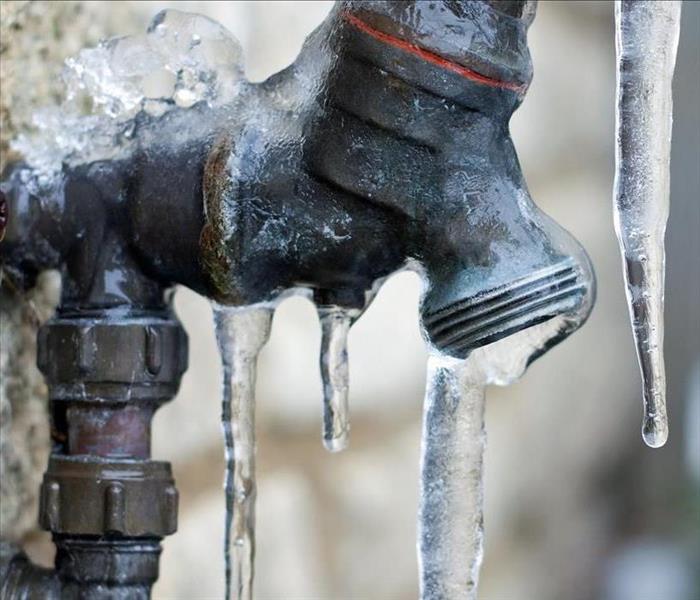 Tips to help prevent pipes from freezing
Tips to help prevent pipes from freezing
Frozen pipes are caused by three factors: rapid temperature dips, insufficient insulation, and thermostats set too low.
- Insulate. Even if you live in a climate where freezing is unusual, pipe insulation in your home's crawl areas and attic can help. The pipes that are exposed are the most vulnerable to freezing. Remember that the more insulation you use, the better your pipes will be protected.
- Use heat tape or wire. Wrapping pipes with heat tape or thermostatically controlled heat wires is one option. Use only goods that have been approved by a third-party testing organization, such as Underwriters Laboratories Inc., and only for the purpose indicated (exterior or interior). Follow the manufacturer's installation and operation directions to the letter.
- Seal leaks. Locate and completely plug any leaks that enable chilly air to enter the house. To keep the cold out, look for air leaks around electrical cables, dryer vents, and pipes and seal them with caulk or insulation.
- Hoses, valves, and faucets should all be secured outside. Disconnect garden hoses and, if possible, use an interior valve to turn off and drain water from pipes running to outside faucets before winter arrives. This decreases the risk of freezing in the short distance between the home and the pipe.
- Allow the water to drip. It may only require a trickle of hot and cold water to keep your pipes from freezing. When the weather is cold, let warm water trickle from a faucet on an outside wall overnight.
- Make the necessary adjustments to the thermostat. Frozen pipes can also be avoided by keeping your thermostat at the same temperature throughout the day and night. This also helps to lessen the strain on the furnace during periods of extreme cold.
- Open Cabinet doors. This permits heat to reach pipes under sinks and appliances near outside walls that aren't insulated.
Water not coming out of the faucet is one of the first indicators of a frozen pipe. If you notice this, go to the basement and double-check that the water is still on and that there isn't a leak. Continue your check after you've confirmed these two points to ensure that none of your pipes have burst. If you discover that your pipes are frozen but none have burst during your search, you have two options:
- Call a plumber to thaw your frozen. This is usually a better option. You don't know where the frozen pipes are or you can't get to the frozen region if you don't think you can safely thaw the pipes yourself.
- Make an effort to thaw the frozen pipes on your own. Be advised that if this option is not done correctly, it can cause more complications.
Sewer back up!
9/13/2021 (Permalink)
Sewage back ups are very unfortunate events that can happen in any home or commercial property. What causes this type of water damage anyway? Well, typically there are three main categories that a sewer back up happens: damaged sewer pipes, clogs, and tree roots in the sewer system. Let's look at these three areas a bit closer.
- Clogging: Typically if you only have one area of your home that experiences a backup, like a tub or a sink, then there is typically a clog and can be fixed with cleaning the drain. However, if you have the backup in several areas of your home, then there is a blockage at the main or the private that is causing the issue. Unless the blockage is removed, the overflow will continue and will damage your entire home or business area.
- Tree Roots: The roots of large trees in the proximity of a sewer line can often cause severe problems. They can literally grow into the pipes and cause holes and blockages or they may wrap around the sewer line and crush it.
- Damaged Sewer Lines: Older properties with older sewer lines that have not been upgraded can have broken or collapsed lines. All the pipes and sewers in older homes were built using cast iron and clay which can wear off with time, get rusty, and easily break down. Present day plastic sewer lines cannot cause such problems simply because they don’t rust.
Sewage backups are not only hazardous to your health, but they can cause a great amount of structural damage to your home. If you experience a sewage back up do not attempt to flush the toilet. Do not use harsh chemicals to attempt to clean out the drain. This can actually cause more damage and make things worse. Open your windows to let fresh air in. It is also very important to keep pets and children away from the affected area. However, the most important thing to do, is to call for professional help. We here at SERVPRO are always here to help!
Midwest Tornado & Flood
7/7/2021 (Permalink)
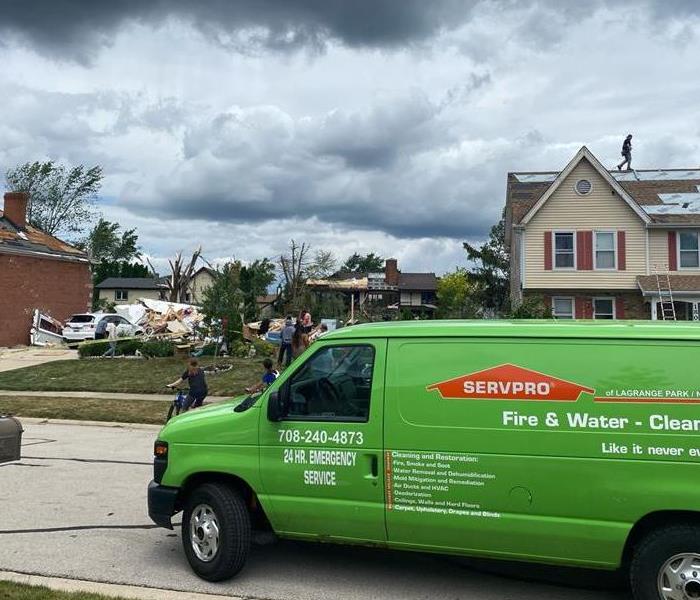 Serving the community!
Serving the community!
Living in the Midwest, you don't hear of many tornadoes coming through the area. If they do, they are mostly more south and don't cause much damage. However, disaster struck two of our suburbs in the middle of the night. The only time we usually hear the tornado sirens go off is when the first Tuesday of the month comes around. However, this was not the case this time. Once the morning hit, we where all able to see the disaster that the tornado has caused to residential homes. There where trees in homeowner's yards that where not there's, trampolines through the side of homes, cars completely smashed, and even an entire home was destroyed. We here at SERVPRO knew that the community needed our help. We immediately stationed our crew in two suburbs that where affected the most, and just handed out water and snacks to anyone that was in need of them. We could see the devastation on people's faces, and all we wanted to do was help as much as we could.
Following the tornado that hit, we then received major flood warnings for almost two weeks. On top of all the homes having property damage to them, they where now dealing with heavy rain fall coming into their homes. This is where our storm team kicked it into gear. Our crew is working around the clock to help restore people's homes, and to give them guidance on what the next step is to take because of these disasters. We can't be more proud to help support our communities during this time. This is why we stand by our saying of being "Faster to Any Size Disaster".
Spring Thaw
3/12/2021 (Permalink)
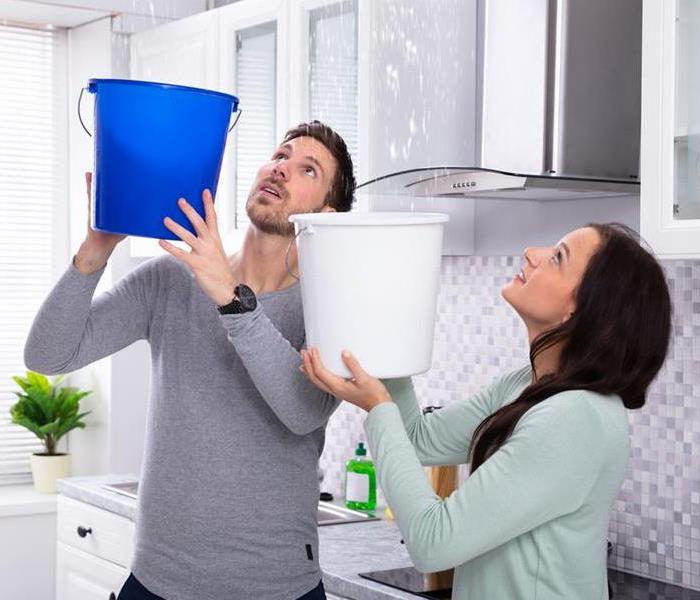 Here are some tips!
Here are some tips!
As we begin to enter Spring season, the process of snow melting can cause water damage to homes and businesses. This will then lead to flooding. It could be minor or major, but still cause water damage problems. Here are some ways to help prevent water damage as we enter this spring thaw out season. Now, you may not be able to prevent water damage under ever circumstance, but you can prepare your home ahead of spring-thaw months to prevent common causes of damage.
1. Basement pumps- install a sump pump or sewer backflow value and keep a battery-operated backup in case of power failure. Also, make sure to consider installing a water alarm that warns when water is accumulating in your basement.
2. Basement storage- Make sure to keep valuable items out of your basement. Removing any electronics or stored valuables from your basement prior to spring-thaw warnings could prove to be an important ounce of prevention.
3. Debris removal- Be sure to remove debris from window wells, gutters and downspouts.
4. Doors and windows- Check for any leaks around doors and windows.
5. Exterior walls- Keep all exterior walls of your home well painted and sealed.
6. Flood drains- If you have flood drains, make sure they work properly.
7. Foundation cracks- Make sure to inspect your foundation for cracks that will allow water seepage and initiate repairs.
8. Fuel tanks- Permanently anchor any fuel tanks.
9. Grading- inspect the grading around your home and make any changes. Design the grading to encourage the water to flow away from your home.
10. landscaping- Make sure to trim trees and bushes away from your home and do not store wood or compost piles nearby.
11. Roof- Keep your roof in good repair. Unless a tree falls on your roof during a storm, most insurers expect you to maintain your roof to prevent water leaks caused by snow melting or torrential downspouts.
Whether you are able to control the situation or not, we here at SERVPRO are always here to help you get your home or business back to like the disaster never even happen. That is way we are always here to help!
Frozen Pipes
1/28/2021 (Permalink)
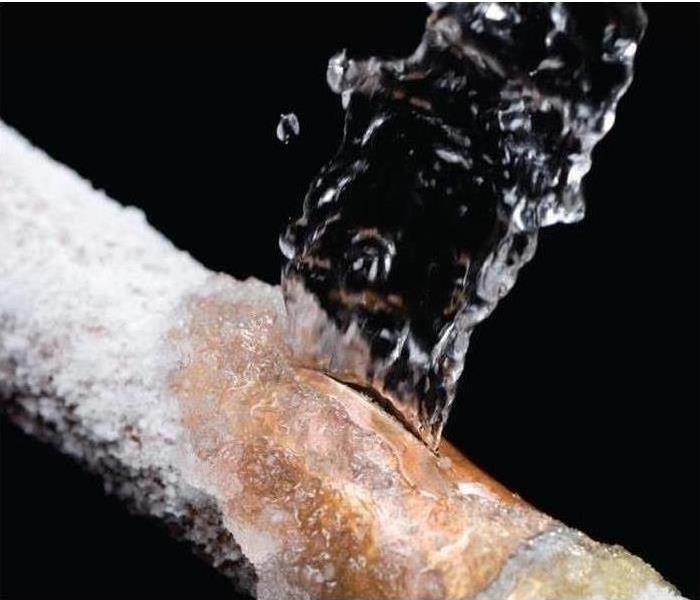 Frozen Pipe
Frozen Pipe
Thawing a frozen pipe the correct way is crucial to minimizing the damage. In order to thaw a frozen pipe, you need to first determine which pipe or pipes are frozen. You can do this by turning on the faucets, and if no water comes out or only a slight trickles out, then you have a frozen pipe. Before you begin attempting to thaw a frozen pipe, you need to open the faucet that the pipe feeds water into. You need to make sure to open both the hot and cold handles. This then will help relieve pressure in the system, and then will allow the water to escape once you begin to thaw the pipe. When beginning to thaw the pipe, you should always start near the faucet then work your way down to the blockage. This will help ensure that the melting ice and steam is able to escape through the open faucet. If you start the thawing process closer to the blockage, the melting ice could get stuck behind the blockage, creating more pressure in the pipe and increasing the chances the pipe will burst. When it comes to thawing the frozen pipe, you could use a hair dryer, heat lamp or portable space heater, hot towels, or electrical heating tape. If the frozen pipe is enclosed, you will need to either turn the heat up in the property, infrared lamp, or cut out a section of the wall to thaw out the frozen pipe/pipes. Remember NEVER attempt to thaw a pipe using an open flame. This can not only damage the pipe, but it can also start a fire in your property. If the frozen water pipe does burst, the first thing you should do is shut off the main water line into your property. This then will prevent additional water from flowing and damaging your property. Then you will need to call a professional, like SERVPRO, to help fix the problem. Therefore, in order to help prevent frozen pipes make sure to keep the heat on in the home, allow faucets to drip slightly, keep all interior doors open, seal up holes and cracks, add extra insulation, and remove exterior hoses and shut off interior valves feeding those hoses.
What WATER can Do – Time to get on it.
12/1/2020 (Permalink)
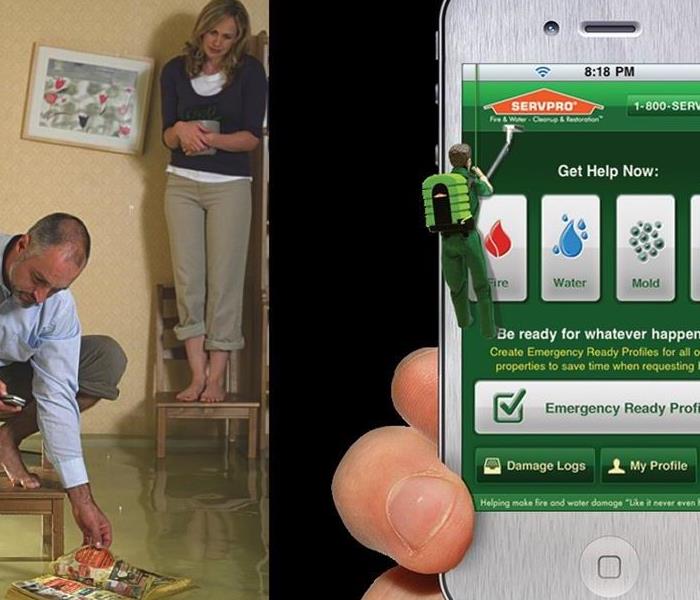 YOU know you want the APP!
YOU know you want the APP!
What WATER can Do – Time to get on it.
Within Minutes
- Water quickly spreads throughout your property, saturating everything in its path.
- Water is absorbed into walls, floors, upholstery, and belongings.
- Furniture finishes may bleed, causing permanent staining on carpets.
- Photographs, books, and other paper goods start to swell and warp.
Hours 1 - 24:
- Drywall begins to swell and break down.
- Metal surfaces begin to tarnish.
- Furniture begins to swell and crack.
- Dyes and inks from cloth and paper goods spread and stain.
- A musty odor appears.
48 Hours to 1 Week:
- Mold and mildew may grow and spread.
- Doors, windows, and studs swell and warp.
- Metal begins to rust and corrode.
- Furniture warps and shows signs of mold.
- Paint begins to blister.
- Wood flooring swells and warps.
- Serious biohazard contamination is possible.
More Than 1 Week:
- Restoration time and cost increase dramatically; replacing contaminated materials and structural rebuilding may be extensive.
Structural safety, mold growth, and biohazard contaminants pose serious risks to occupants.
Costs from water damage
9/1/2020 (Permalink)
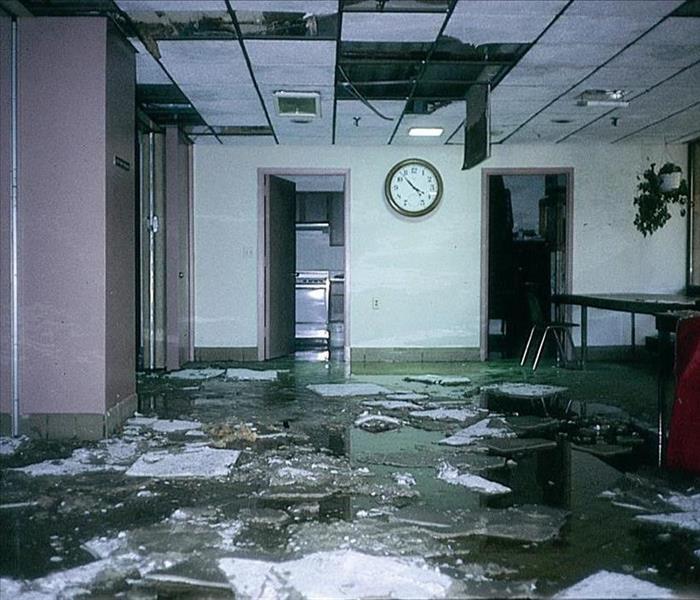 Our SERVPRO team is here to help!
Our SERVPRO team is here to help!
When it comes to owning a business or a home, water damage can be one of the most costly things there is. You can not only lose out on days or weeks of productivity, but you could also find yourself repairing or replacing valuable equipment like electronics, tools and inventory. This is where the costs come into play.
- On average, water damage from a sink will run $7,000.00 for each instance
- For toilets, that number ranges between $2,000.00 and $10,000.00
As we can see, this can add up very fast! Here are some causes of water damages, and what you can do to help prevent them.
1. Appliances and Equipment
- Air conditioners, water heaters or anything that uses tubes, pipes, gaskets or filters to operate has the potential to leak. The best thing to do is to regularly look over and maintain your equipment. If you notice anything that concerns you, such as rust, cracks, bulges or signs of moisture, call SERVPRO.
2. Roofing
- Make sure you're checking your roof regularly. If you've got a pond up there, your drainage isn't working effectively. Keep in mind that every inch of water weighs in at around 5 lbs. Be sure to look for any damage to your perimeter flashing, roof membrane or roof penetrations like drains, pipes and gas lines.
3. Pipes and Drains
- Your plumbing system is susceptible to stoppages, clogs and dmage. If a crack develops, it could dumb 250 gallons of water per day on your facility. Look for outward signs of moisture, blue stains, rusting, and cracking and bulging. If you're having plumbing work done or you have a cut pipe for any reason, check for scale buildup. You can also try a pipe camera to get a good look at what's going on inside your system.
4. Sprinkler Systems
- Many commercial buildings are outfitted with sprinkler systems, which are great for minimizing fire damage, but not so great for water damage when they malfunction. Always check your sprinkler system for signs of damage or rust, and replace them regularly to make sure they are functioning properly.
5. Mother Nature
- Natural disasters like hurricanes, severe thunderstorms ad flash flooding can do untold damage to your business. You can control how ready you are for it though. Keeping your gutters clear, installing barriers and storing sensitive files and electronics at a higher level are all things you can do to keep the damage minimal. Consult with a SERVPRO professional to get your ERP set up and ready in case something like this were to happen.
Key takeaways for preventing water damage
7/23/2020 (Permalink)
Water damage is the No. 1 culprit that weakens your home's foundation and the very core that holds your house together. I am sure you have heard about core strength for your body. Well, water damage hits at the core strength of your home, eventually causing serious structural damage. Damp wood invites termites and carpenter ants. It can also cause mold and mildew if not taken care of properly.
Here is how to prevent water damage using three easy strategies that will give you peace of mind the next time heavy storms hit.
1. Ensure good drainage
- clean your gutters
- direct downspouts 5-10' away from the house
- slope your yard away from the foundation
2. Test your sump pump
- check your sump pump once a year
- test more frequently during storm season
3. Fix water leaks
- repair any noticeable dripping pipes
- check for dark spots under pipes & on ceilings
- repair any cracked caulking
- inspect the roof for missing, loose of damaged shingles
By following these tips, you are going to have less of chance when it comes to the amount of water damage that the home may take on.
First Steps After Home Water Damage
2/11/2020 (Permalink)
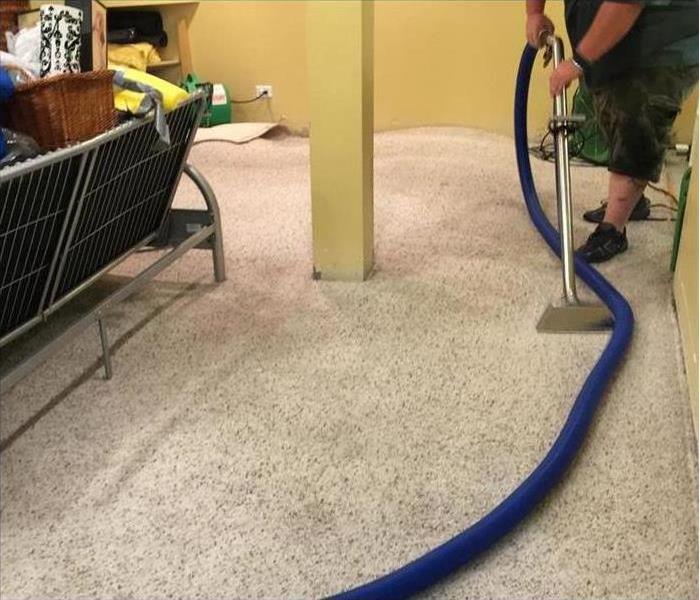 Water extraction in a Prospect Heights, IL
Water extraction in a Prospect Heights, IL
Water-related property damage is among the top three causes of homeowner’s insurance filings. If you have experienced water damage in your Prospect Heights, IL, home, you may know it’s not easy to make logical decisions in a crisis. This simple outline may help you chart your course.
The Source
If the source of the offending water is inside your home, as is the case with broken pipes or leaky appliances, turning off your water main valve should stop the problem. If external water, such as rising floodwater, infiltrated your home, it’s best to prioritize safety and seek higher ground until the water subsides.
Safety Check
Consider taking the following important safety precautions before entering the flooded area:
- Keeping children and animals safely away from the water damage
- Disconnecting your electrical panel
- Ventilating with windows and fans
- Wearing waterproof waders and gloves
- Ventilating generator fumes properly
If you’ve checked off that safety list, you are ready to begin or arrange for someone to begin the cleanup. If you were not able to deactivate your electrical, or if your damage was caused by a flood, it is important you seek assistance from an emergency water remediation service. Floodwater can be highly contaminated with sewage, chemicals, and other hazards. It would not be wise to begin the cleanup without a specialist to supervise the process.
Do-it-Yourself Cleanup
If your water damage is fairly minor, less than one inch of standing water, you can begin removing the water with a wet vacuum once you’ve taken the safety precautions. Set up a drying area in the garage or on a patio so you can spread items out to dry. Strong ventilation will help prevent mold growth.
Insurance
Once safety has been addressed and cleanup has begun, it’s a good idea to notify your insurance provider. Your agent will be able to summarize your coverage and initiate a claim.
A water-damage event in your home can be unsettling. Before you begin the water cleanup, it’s important to stop the source, prioritize safety precautions and hire professional support. Start there, and you and your family will be back to normalcy before you know it.
4 Hidden Dangers of Water Leaks
1/28/2020 (Permalink)
 Ceiling damage in Arlington Heights, IL
Ceiling damage in Arlington Heights, IL
Here are Some of the Hidden Dangers of Water Leaks
At first glance, a water leak may not seem like a major cause for concern. However, even small leaks can pave the way for severe water damage and high utility bills. As a business owner in the Arlington Heights, IL, area, knowing what to do in the event of a leak is critical to your company’s success. Here are some of the hidden dangers of water leaks that you should look out for to keep your business protected.
1. Ceiling Damage
If you have a roof leak that resulted from a pipe break, you will likely begin to notice damage to your ceiling. Once your ceiling becomes harmed, the damage may start to spread to other areas of your building, such as the walls and ceiling lights. As soon as you notice that your roof is leaking, call a professional to have the leak repaired and to prevent further harm.
2. Mold Damage
Any area of your building that contains adequate moisture is vulnerable to mold growth. When there is a water leak in your building, you have a much higher chance of encountering mold damage. Even small, steady leaks may lead to visible mold growth that can spread rapidly.
3. High Utility Bills
A higher water bill is expected when you’re dealing with a leak in your business. However, ongoing water damage may also lead to increased energy consumption, which can cause your utility bills to skyrocket. This typically occurs as a result of damaged insulation and a greater loss of warm and cold air.
4. Structural Damage
If a leak persists for long enough, it can compromise the integrity of your commercial building. Structural damage from water leaks may include deteriorated walls, rafters, wood flooring or ceiling joists. Not only are these repairs expensive, but they can also slow down your business.
A water leak is a problem that should be taken seriously. If you notice any signs of damage in your business, don’t hesitate to take action and call for a water damage repair immediately.
How To Clean Up Water Damage
12/6/2019 (Permalink)
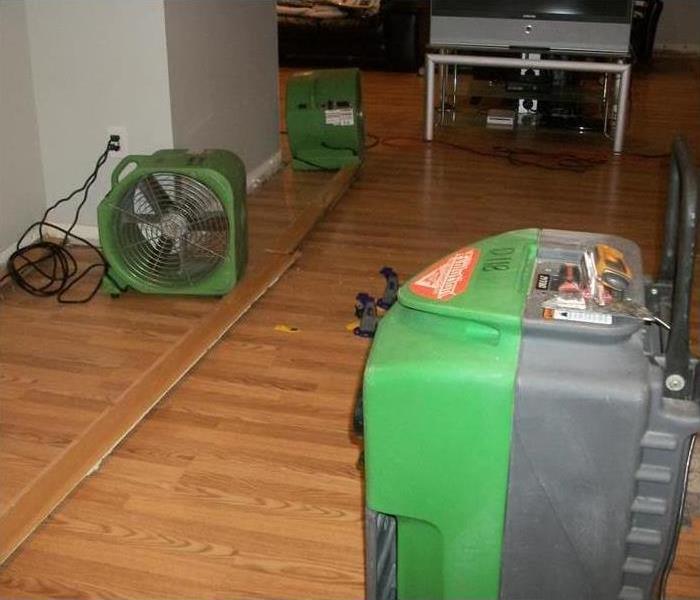 Drying remaining water in a Prospect Heights, IL home
Drying remaining water in a Prospect Heights, IL home
Water Restoration Process
Water damage to your Prospect Heights, IL, home can be a major hassle. The sooner you begin cleanup, the less likely you are to have secondary problems, such as mold growth. The following steps will guide you through the restoration process.
Address the Water Source
The flooding may be due to broken pipes, a leaky roof or any number of other causes. You have to stop the flow of water before beginning cleanup. Although a temporary solution may allow you to get started on the restoration process, it is important to fully repair the problem to prevent future flooding.
Assess the Water Damage
Consider the size of the affected area and the amount of water present. Check for signs of mold growth. Decide if you will be able to handle the restoration process yourself.
Remove Standing Water
The amount of water present determines the best way to remove standing water. You may be able to scoop the water out with buckets, or you may need to use special pumps or vacuums.
Dry Remaining Water
After the standing water has been removed, you will still have to contend with wet furnishings, carpet, etc. You can use fans and dehumidifiers to help with this step of the water cleanup process. If the outside humidity is low enough, you can open windows and doors.
Sanitize Affected Areas
Depending on the level of contamination in the water, it may be necessary to clean the surfaces that came into contact with the floodwater. In many cases, a store-bought antibacterial cleaner will be sufficient. More severe cases may call for harsher detergents.
Repair and Replace Damaged Items
Throw out any items that you are unable to fully dry and sanitize. Other items may be too damaged to repair, but some may only need a new coat of paint.
Don’t worry if the above steps seem overwhelming. A professional restoration service can repair water damage and get your home back to normal quickly and safely.
Replacing Your Toilet Is As Easy As 1-2-3
10/18/2019 (Permalink)
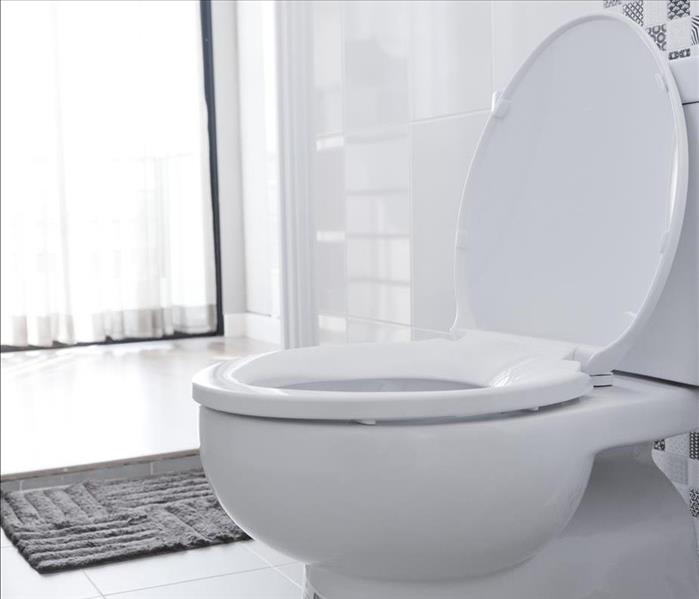 Replacing a leaking toilet in Prospect Heights, IL, isn't as big of a deal as you may think it is
Replacing a leaking toilet in Prospect Heights, IL, isn't as big of a deal as you may think it is
Replacing Your Toilet Is As Easy As 1-2-3
Replacing a leaking toilet in Prospect Heights, IL, isn't as big of a deal as you may think it is. Turns out, you probably don't even have to call a plumber. If you have a toilet picked out and waiting at your home, why not install it yourself?
Step 1- Removal
No matter what your reason for wanting a new toilet, it's never a bad idea to update your bathroom appliances. However, before you can install it, you have to get your old toilet out of there. Here's how to go about it:
- Shut off the water to the toilet.
- Flush the toilet until all the remaining water is gone.
- Disconnect the water supply line.
- Gently rock the toilet back and forth to break the wax seal.
- Lift the toilet out and take it away.
Step 2- Preparation
If your previous leaking toilet caused water damage, you'll want to hire a water damage remediation service to take care of any problems before you install the new one. Once that's taken care of, make sure you have all the proper supplies and tools you will need: a toilet, a new wax gasket, a wrench and a screwdriver. Prepare the area by setting the wax seal on the flange where the toilet will sit. If you're also replacing the supply tube, apply pipe-joint compound to either end.
Step 3- Replacement
The final step of your toilet repair is to gently place your new porcelain throne onto the wax seal and bolts. Use your weight to push down toilet onto the gasket. Replace the washers and nuts onto the bolts holding the toilet down and tighten with a wrench. Continue you press down the toilet and tighten alternatively, until it no longer feels loose after pressing it. Lastly, reconnect the loose end of the supply line to the shut-off valve. Re-open the valve and flush the toilet to refill it.
Sometimes, you can't fix a leaking toilet. That's when you need to step up and put a new one in. Even people without much plumbing experience can do this at home with the proper guidance.
The Aftermath of Bursting Pipes
8/27/2019 (Permalink)
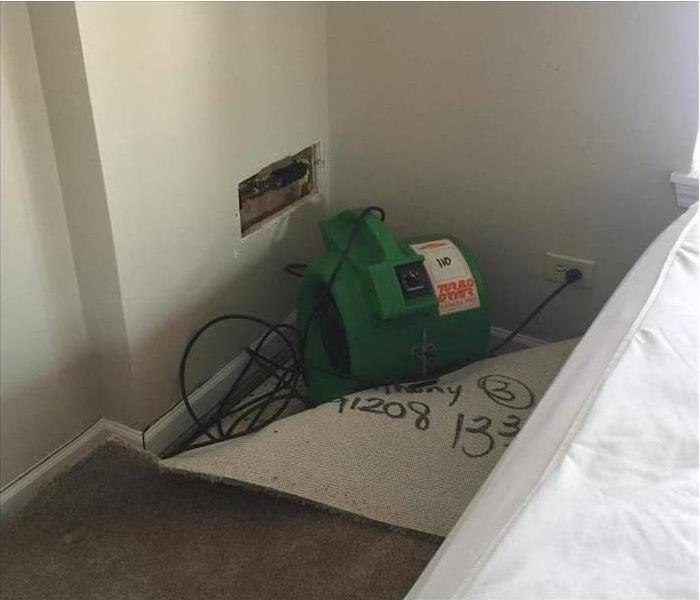 Burst pipe in a Prospect Height, IL home
Burst pipe in a Prospect Height, IL home
Dealing with water damage in Prospect Heights, IL, can be a homeowner’s nightmare. When it’s cold outside, water can freeze and expand, leading to bursting pipes and a flooded home. Cleanup can be expensive. Thankfully, homeowner’s insurance can help with the financial burden, and there are a few things you can do to help make the process easier.
Emergency Repairs
In general, you want to wait for your homeowner’s insurance company to approve your claim before you start the main cleanup process or attempt to fix the broken pipe. However, there are a few simple things you can do to help prevent further damage:
- Remove excessive water.
- Turn off the water supply to your home.
- Take valuable items that have not been damaged and move them to a safer location.
Check Your Policy
Homeowner’s insurance policies can vary widely when it comes to what is covered. For example, your policy may include damage from bursting pipes but not from a washing machine that malfunctioned. Your best bet is to read your policy yourself so you are aware of what your coverage is.
Have Proper Documentation
Documentation is a crucial step when you are making a water claim. Consider taking photographs and video when necessary to show the extent of the damage. A photo of the room from before the damage occurred can also be helpful if you have one handy. Be sure to include any receipts you have for items that have been damaged or destroyed. If, during your emergency repairs, you had to rent equipment or buy any supplies, keep track of your receipts so you can be reimbursed for them. Any documentation you can provide will likely help with the claim process.
These things can help make the process of your water damage repair from bursting pipes go more smoothly. Emergency repairs can prevent further damage, knowledge of your policy prevents misunderstandings, and documentation should help with the claim process. Hopefully, you will be able to have the damage repaired quickly and have life return to normal.
Basement Flood? We Can Help!
6/28/2019 (Permalink)
A basement can flood at any time, although flooding most often occurs during heavy rainfall. Basements are inherently prone to flooding because they are the lowest level of a building and are normally built partly or entirely below ground level. There are a number of reasons why your basement could flood, including:
- A blocked or failed sewer lateral pipe
- Heavy rain causes surface water to pool around your home
- Storm sewer backup
- Sanitary sewer backup
- Foundation drainage failure
- Water supply-line break or hot-water tank failure
- And many more
Have Questions about Basement Flooding?
Call Today - (847) 637-3445
If flood water is not handled quickly and properly, it can jeopardize your health and safety, and cause severe damage to your home’s structure. Remember, the longer you wait, the worse the problem will get.
The bottom line: a flooded basement can jeopardize your health, safety, and your home’s integrity. It’s worth making a call to SERVPRO of Arlington Heights/Prospect Heights and let our trained, professional crews handle the situation safely and correctly. We have earned the trust of hundreds of homeowners, business owners, and property professionals.
We are Flooded Basement Specialists:
- We are Available 24 hours/7 days per week
- We’re a Preferred Vendor to many National Insurance Companies
- We Bill The Insurance Directly – One Less Thing For You To Worry About
- Our Technicians are Highly-Trained in Water Restoration Techniques
- We use s500 IICRC Restoration Standards
- Advanced Inspection and Extraction Equipment
Basement Flooded? Call SERVPRO of Arlington Heights/Prospect Heights Today – We’re Ready To Help (847) 637-3445.
What You Should Know About Water Damage and Your Insurance Policy
6/11/2019 (Permalink)
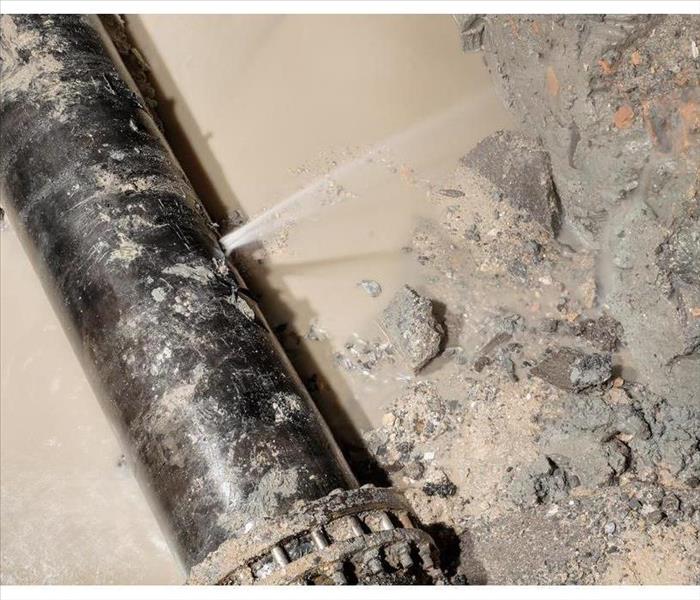 A leaky pipe will likely be covered
A leaky pipe will likely be covered
Questions You Might Have Regarding Your Policy
If a pipe breaks in your Prospect Heights, IL home and causes water to flood your home, the good news is that this will most likely be covered by your homeowners insurance. While this is usually a covered peril, however, there are some exceptions. The following are a few questions that you might have regarding your policy.
1. When is Damage Covered by Insurance?
When you experience water damage from a broken or leaky pipe, the cost of resulting damage will likely be covered. If the flood is the result of a broken pipe caused by freezing weather or a sudden accident, this will usually be included in your policy. However, you will often be required to pay for any costs related to repairing and replacing the pipe.
2. When is Damage Not Covered by Insurance?
If the insurance company believes that the pipe has broken as a result of your own negligence, then you will likely be denied insurance coverage. This can happen if you have not taken proper precautions to prevent freezing pipes during cold weather or if you have failed to maintain your home. You may also be required to pay for damages if you wait too long to contact your insurance company and the damage has worsened in the meantime.
3. What Should You Do When You Discover the Damage?
To prevent your insurance company from denying your claim, you should be sure to contact them as soon as possible. You should also hire a water damage remediation company to fix the broken pipe and do any necessary repairs in your home. While you wait for workers to arrive, you can begin documenting the damage and making temporary repairs to prevent water from spreading.
While a flood in your home can cause a lot of worry, the claims process can go more smoothly if you take the appropriate actions. Performing regular maintenance on your home can prevent problems and will make it easier to be approved for coverage if an accident does happen.
Water damaged home in Prospect Heights
5/27/2019 (Permalink)
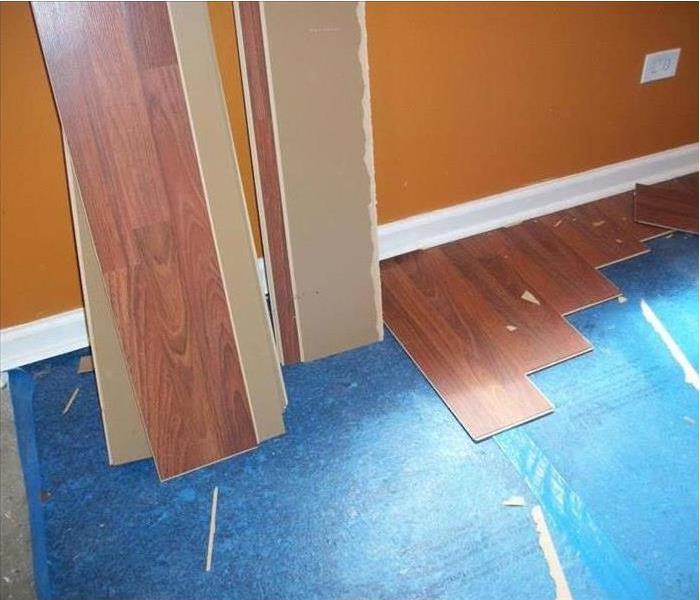 Water Damage in a basement in Prospect Heights, IL.
Water Damage in a basement in Prospect Heights, IL.
Water Damage
SERVPRO of Arlington Heights/ Prospect Heights specializes in the cleanup of flooded basements and any damage caused by water in your home.
We were recently called out to help with the cleanup of this flooded basement in Prospect Heights, IL. As a result of the flooding, our technicians needed to pull all of the flooring out as it was badly affected by the water.
If you are a home owner, a business owner or a property manager that experiences a water damage due to heavy rain, a burst pipe or any other reason, why not give our office a call at (847) 637-3445 to help with the clean up?
SERVPRO of Arlington Heights/Prospect Heights has the experience and the know how to perform the necessary clean up and to make your situation seem “Like it never even happened.” Browse our website for more details on our other types of services.
Spring showers are coming..!
5/27/2019 (Permalink)
 Spring showers are coming and SERVPRO of Arlington Heights/ Prospect Heights is here to help you.
Spring showers are coming and SERVPRO of Arlington Heights/ Prospect Heights is here to help you.
Will you be prepared if those Spring showers not only bring you lovely flowers but also bring you an unwanted flooded home or place of business??
Water Damage or Flooded Properties
SERVPRO of Arlington Heights/Prospect Heights is a trusted leader in the Water Restoration industry and has got you covered!
We specialize in the cleanup of flooded properties so why not give our office a call should this occur, we are available 24 hours a day and 7 days a week!
We'll clean it up and make it seem "Like it never even happened."
3 Common Water Issues in Commercial Buildings
4/18/2019 (Permalink)
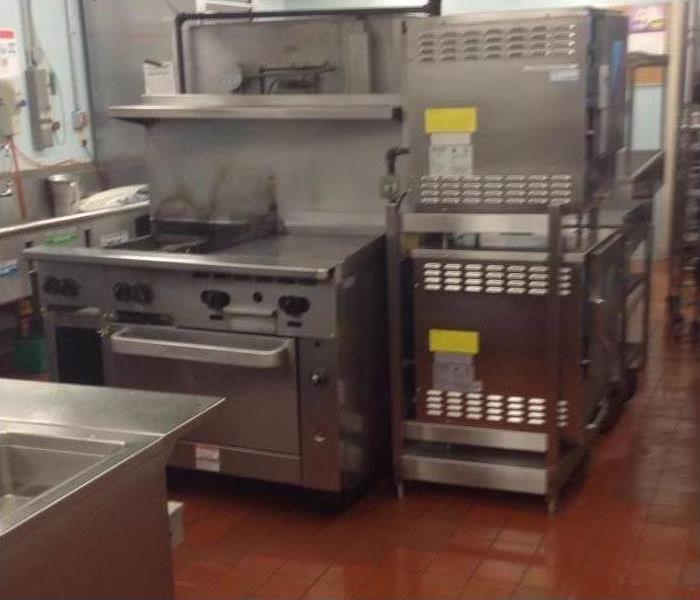 Blocked drains can shut down a sink, room or plumbing zone.
Blocked drains can shut down a sink, room or plumbing zone.
Commercial buildings are a maze of hot-water and cold-water supply pipes and drains. The water lines and sprinkler heads of the fire suppression system complicate the picture. Leaking pipes are everyday occurrences. You learn to expect the occasional flood or pipe break. The only surprise comes when the plumbers run out of problems to fix. Following are the three most common problems faced in commercial plumbing.
1. Small Nuisance Problems
These problems have quick and easy fixes. Dripping faucets and leaking pipes are commonplace in restroom and kitchen areas. Fixing these problems saves water and eliminates the hazards associated with wet floors. Small repairs like this provide plumbers the opportunity to inspect the surrounding plumbing and fixtures. Not every plumbing problem gets reported.
2. Toilet Problems
Toilet design is all about performing the flush using the least possible amount of water. It takes a delicate balance of water volume and pressure for a successful flush. When conditions aren’t correct, the result is a toilet backup. Some problem toilets frequently block. They may need a new flush valve or total replacement.
3. Blocked, Slow and Foul-Smelling Drain Problems
Blocked drains can shut down a sink, room or plumbing zone. A slow drain provides a warning that it will eventually stop completely. Plumbers know that drain-flow problems require prompt attention.
Drain odors from a sink may mean that the trap is dry. A dry trap allows smells and sewer gas to leak into the building. Traps attached to floor drains can dry out as well. Pouring water down the drain is a simple fix for dry traps. If the odor problem persists, it becomes a problem for the custodial staff to handle.
Leaking pipes can cause a flood. The subsequent water damage and the risk of mold are a threat to your business. There are water damage remediation specialists located in the Arlington Heights, IL area. They can help minimize the impact of water damage and keep your business up and running. It all starts with a phone call.
Four Ways To Prevent Mold Growth in Your Home
3/25/2019 (Permalink)
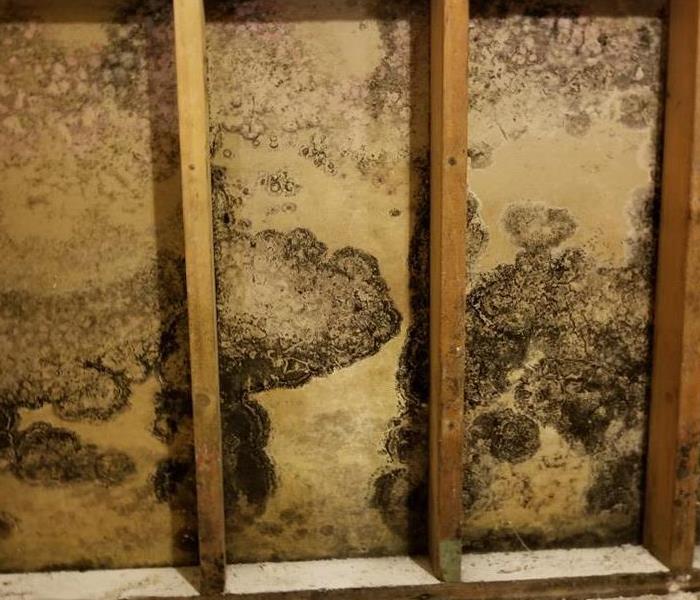 If your home has high humidity, then you are more likely to find a mold growth.
If your home has high humidity, then you are more likely to find a mold growth.
Four Ways To Prevent Mold Growth In Your Home
If you have mold growing in your Arlington Heights, IL home, and you don’t know how to deal with it, you might feel stressed and frustrated. However, there are several things that you can do, such as preventing water damage, to keep a growth from forming. Keep these things in mind if you have a fungus problem in your house.
1. Fix Leaks Immediately
Because mold growth happens more quickly in moist environments, you should be sure to repair any leaks in your home as soon as possible. Whether the water is coming from a window, the plumbing or the roof, this is prime breeding space for mold. Even if the leak is small, it can cause enough water damage over time to become a large problem.
2. Keep Humidity Levels Low
If your home has high humidity, then you are more likely to find a mold growth. You can use a dehumidifier or an air conditioner to help keep humidity at an appropriate level.
3. Ventilate Areas That Are Prone to Mold
Active mold prevention is more often required in rooms where you use a lot of water, such as the bathroom, kitchen and laundry room. Keeping these areas ventilated can help. You should also make sure to dry any spaces where water tends to build up.
4. Clean Regularly
Regular maintenance and cleaning of your home is perhaps the best way to prevent mold. If you are cleaning on a regular basis, especially with products that kill mold spores, then the fungus will not have a chance to grow and spread.
While there are many ways that you can prevent mold, it can also be helpful to hire a professional mold remediation service if the problem is too large for you to handle on your own. Particularly if you have extensive water damage, it is a good idea to get outside help. A professional service can remove the mold, as well as repair the damage and prevent it from returning.
IICRC Categories and Classes
3/4/2019 (Permalink)
When you call to report a water loss in your business or home wouldn't it be nice to be able to give the person on the other end an idea of the type of loss you are experiencing. The IICRC has set guidelines for restoration companies to follow as a standard. These standards tell us what can stay and what has to go. We are not making up our own rules, like in monopoly. We follow the guidelines set be a 3rd party, the IICRC.
Categories of water – This refers to the amount of contamination in the water.
Category 1 – Water originates from a sanitary source and does not pose substantial risk from dermal, ingestion, or inhalation exposure.
Category 2 – Water contains significant contamination and has the potential to cause discomfort or sickness if contacted or consumed by humans.
Category 3 – Water is grossly contaminated and can contain pathogenic, toxigenic, or other harmful agents.
Classes of water – This refers to how wet an area, room, or structure has become.
Class 1 (least amount of water absorption and evaporation load) – Water intrusion where wet, porous materials (e.g., carpet, gypsum board, fiber-fill insulation, concrete masonry unit (CMU), textiles) represent less than ~5% of the combined floor, wall, and ceiling surface area in the space and where materials described as low evaporation materials
(e.g., plaster, wood, concrete, masonry) or low evaporation assemblies (e.g., multilayer wallboard, multilayer subfloors, gym floors, or other complex, built-up assemblies) have absorbed minimal moisture.
Class 2 (significant amount of water absorption and evaporation load) – Water intrusion where wet, porous materials (e.g., carpet, gypsum board, fiber-fill insulation, concrete masonry unit (CMU), textiles) represent ~5% to ~40% of the combined floor, wall, and ceiling surface area in the space and where materials described as low evaporation materials (e.g., plaster, wood, concrete, masonry) or low evaporation assemblies (e.g., multilayer wallboard, multilayer subfloors, gym floors, or other complex, built-up assemblies) have absorbed minimal moisture.
Class 3 (greatest amount of water absorption and evaporation load) – Water intrusion where wet, porous materials (e.g., carpet, gypsum board, fiber-fill insulation, concrete masonry unit (CMU), textiles) represent more than ~40% of the combined floor, wall, and ceiling surface area in the space and where materials described as low evaporation materials (e.g., plaster, wood, concrete, masonry) or low evaporation assemblies (e.g., multilayer wallboard, multilayer subfloors, gym floors, or other complex, built-up assemblies) have absorbed minimal moisture.
Class 4 (deeply held or bound water) – Water intrusion that involves a significant amount of water absorption into low evaporation materials (e.g., plaster, wood, concrete, masonry) or low evaporation assemblies (e.g., multilayer wallboard, multilayer subfloors, gym floors, or other complex, built-up assemblies). Drying may require special methods, longer drying times, or substantial water vapor pressure differentials.
SERVPRO of Arlington Heights / Prospect Heights
847-637-3445
Water Damage From Garden Hose
7/5/2018 (Permalink)
A 25-foot, 1/2-inch diameter hose attached to a faucet that supplies water at 40 psi has a flow rate of 24 gallons per minute, while a 100-foot hose only has a flow rate of 6 gallons per minute. That is a lot of water coming from a garden hose. That is why it is so important to make sure that when you are out watering your garden or flowers that you keep an eye on the hose. Walking away from your hose while it is on can cause water to flow into your home and cause water damage.
A leaking garden hose can also cause water damage to your home as well as mold damage due to the long period of time that the water might be entering your home. Here are some things you should look for when you come across a leaking water hose, and how you can stop the water from entering your home.
The most important thing to determine is where the leak on your hose is actually coming from. This shouldn’t be too difficult to do, but depending on the location will determine the severity of the problem and how much effort it will take to fix it. If your hose always leaks from around the connection to the water tap, you may have either a problem with the spigot itself, or the hose fitting. If water wells up around the handle, your packing washer may be worn out, or the packing nut may need to be tightened, but if water only leaks when your hose is secured to the faucet, then you need to see if the water is welling up around the actual connection, or from below the fitting.
If you find that you have water damage to your home due to water entering your home from the garden hose, SERVPRO of Arlington Heights/Prospect Heights is here to help. Give us a call at 847-637-3445.
Sewage Backup Causes
6/20/2018 (Permalink)
Sewage backups are very unfortunate events that can happen in any home or commercial property. What causes this type of water damage anyway? Well, typically there are three main categories that a sewer back up happens: damaged sewer pipes, clogs, and tree roots in the sewer system. Let's look at these three areas a bit closer.
- Clogging: Typically if you only have one area of your home that experiences a backup, like a tub or a sink, then there is typically a clog and can be fixed with cleaning the drain. However, if you have the backup in several areas of your home, then there is a blockage at the main or the private that is causing the issue. Unless the blockage is removed, the overflow will continue and will damage your entire home or business area.
- Tree Roots: The roots of large trees in the proximity of a sewer line can often cause severe problems. They can literally grow into the pipes and cause holes and blockages or they may wrap around the sewer line and crush it.
- Damaged Sewer Lines: Older properties with older sewer lines that have not been upgraded can have broken or collapsed lines. All the pipes and sewers in older homes were built using cast iron and clay which can wear off with time, get rusty, and easily break down. Present day plastic sewer lines cannot cause such problems simply because they don’t rust.
Sewage backups are not only hazardous to your health, but they can cause a great amount of structural damage to your home. If you experience a sewage back up do not attempt to flush the toilet. Do not use harsh chemicals to attempt to clean out the drain. This can actually cause more damage and make things worse. Open your windows to let fresh air in. It is also very important to keep pets and children away from the affected area. However, the most important thing to do, is to call for professional help.
SERVPRO of Arlington Heights/Prospect Heights is here to help with all your water damage needs. We are open 24/7/365 to help. Call us at 847-637-3445.
Reasons Sump Pumps Fail
6/15/2018 (Permalink)
It is spring time in Arlington Heights, and the one thing we know is that rain is never far behind. With the spring rains comes the sump pump failure calls from homeowners. Often we are asked, how does this happen and why does my sump pump fail? The following is some of the top reason we have seen sump pumps fail.
Power failures: When the electricity goes out, and the sump pump does not have a battery backup or the battery backup is not fully charged there is no way for the pump to do their job. Making sure that your battery backup system is fully charged before a storm the best way to ensure you don’t have water backing up into your home.
Wrong size sump pump: When you have an undersized pump it causes the pump to have to work extra hard to remove the water from your home. If the pump is too big, it has to work harder, and in return the life span is lessened.
Defective sump pump: Yes, it does happen that at the time of install the sump pump is defective. It is wise to test the pump when it is initially installed to make sure the pump operates properly.
Frozen of Clogged Lines: If the water cannot exit, the pump does not work. Protecting the water’s exit point of the discharge pipe will keep debris and animals out of the system, making it optimal for your sump pump.
Switch Problems: The switch is the main mechanical reason for sump pump failures. This occurs when the pump shifts from its position inside the basin, rendering the float ineffective. Float is responsible for the smooth operation of the on/off switch. Your sump pump relies on both the switch and the float arm mechanisms to operate effectively.
Last, but not least is Lack of Maintenance: Most sump pumps should be ran every 2-3 months per most manufactures instructions. Testing to make sure your sump pump works before rainy season hits is also recommended.
If you have a sump pump failure this spring, SERVPRO Arlington Heights/Prospect Heights is here to help. Give us a call at (847) 637-3445.
We Are Faster To Your Water Disaster
6/11/2018 (Permalink)
Flooding and water emergencies don’t wait for regular business hours and neither do we. SERVPRO of Arlington Heights/Prospect Heights provides emergency cleaning and restoration services 24 hours a day, 7 days a week—including all holidays.
Faster To Any Size Disaster
Flooding and water damage is very invasive. Water quickly spreads throughout your home and gets absorbed into floors, walls, furniture, and more. SERVPRO of Arlington Heights/Prospect Heights arrives quickly and starts the water extraction process almost immediately. This immediate response helps to minimize the damage and the cleaning and restoration costs.
Need Emergency Service? Call Us 24/7 – 847-637-3445.
Water Damage Timeline
Within Minutes
- Water quickly spreads throughout your property, saturating everything in its path.
- Water is absorbed into walls, floors, upholstery, and belongings.
- Furniture finishes may bleed, causing permanent staining on carpets.
- Photographs, books, and other paper goods start to swell and warp.
Hours 1 - 24:
- Drywall begins to swell and break down.
- Metal surfaces begin to tarnish.
- Furniture begins to swell and crack.
- Dyes and inks from cloth and paper goods spread and stain.
- A musty odor appears.
48 Hours to 1 Week:
- Mold and mildew may grow and spread.
- Doors, windows, and studs swell and warp.
- Metal begins to rust and corrode.
- Furniture warps and shows signs of mold.
- Paint begins to blister.
- Wood flooring swells and warps.
- Serious biohazard contamination is possible.
More Than 1 Week:
- Restoration time and cost increase dramatically; replacing contaminated materials and structural rebuilding may be extensive.
- Structural safety, mold growth, and biohazard contaminants pose serious risks to occupants.
About SERVPRO of Arlington Heights/Prospect Heights
SERVPRO of Arlington Heights/Prospect Heights specializes in the cleanup and restoration of residential and commercial property after a fire, smoke or water damage event. Our staff is highly trained in property damage restoration. From initial and ongoing training at SERVPRO’s corporate training facility to regular IICRC-industry certification, rest assured our staff is equipped with the knowledge to restore your property.
24 Hour Emergency Water Damage Service
6/7/2018 (Permalink)
SERVPRO of Arlington Heights/Prospect Heights is available 24 hours a day for water emergencies, large or small. When you are dealing with water damage, immediate action is crucial. A delay of just a few hours can greatly increase the severity of the water damage.
We Answer the Phone Ready to Help
Call Today - (847) 637-3445
We understand that when you call us, you may be feeling confused, stressed, and vulnerable. You need an expert to guide you through this crisis. SERVPRO of LaGrange Park/North Riverside has the specific water damage training and experience to help you through this tough time. We specialize in water damage restoration—in fact, it's the cornerstone of our business.
What to Expect
When you call, we will ask several questions regarding your water damage emergency. These questions will help us determine what equipment and resources to bring, including how many trained SERVPRO Professionals may be needed.
Our SERVPRO Representative will ask several questions:
- Your name and contact information
- Your insurance information (if applicable)
- The street address of the water-damaged home or business
- When did the flooding or water damage occur?
- What caused the water damage (if known)?
- Is there electricity available (on-site)?
SERVPRO of Arlington Heights/Prospect Heights specializes in the cleanup and restoration of residential and commercial property after a fire, smoke or water damage event. Our staff is highly trained in property damage restoration. From initial and ongoing training at SERVPRO’s corporate training facility to regular IICRC-industry certification, rest assured our staff is equipped with the knowledge to restore your property.
Sewage Backup Causes
6/7/2018 (Permalink)
Sewage backups are very unfortunate events that can happen in any home or commercial property. What causes this type of water damage anyway? Well, typically there are three main categories that a sewer back up happens: damaged sewer pipes, clogs, and tree roots in the sewer system. Let's look at these three areas a bit closer.
- Clogging: Typically if you only have one area of your home that experiences a backup, like a tub or a sink, then there is typically a clog and can be fixed with cleaning the drain. However, if you have the backup in several areas of your home, then there is a blockage at the main or the private that is causing the issue. Unless the blockage is removed, the overflow will continue and will damage your entire home or business area.
- Tree Roots: The roots of large trees in the proximity of a sewer line can often cause severe problems. They can literally grow into the pipes and cause holes and blockages or they may wrap around the sewer line and crush it.
- Damaged Sewer Lines: Older properties with older sewer lines that have not been upgraded can have broken or collapsed lines. All the pipes and sewers in older homes were built using cast iron and clay which can wear off with time, get rusty, and easily break down. Present day plastic sewer lines cannot cause such problems simply because they don’t rust.
Sewage backups are not only hazardous to your health, but they can cause a great amount of structural damage to your home. If you experience a sewage back up do not attempt to flush the toilet. Do not use harsh chemicals to attempt to clean out the drain. This can actually cause more damage and make things worse. Open your windows to let fresh air in. It is also very important to keep pets and children away from the affected area. However, the most important thing to do, is to call for professional help.
SERVPRO of Arlington Heights/Prospect Heights is here to help with all your water damage needs. We are open 24/7/365 to help. Call us at 847-637-3445.
Avoid Water Damage by Routine Gutter Maintenance
6/5/2018 (Permalink)
According to our friends at Farmers Insurance, "Cleaning out your gutters is very important. If you’re seeing lots of leaves, birds’ nests, sticks, and whatnot up there, your gutters may not be doing the job you hired them for. And on a rainy day, a clogged gutter can send water spilling into your home’s foundation, through the roof, or down to your basement. That could cause some serious water damage! So next time you’re doing some seasonal cleaning, make sure those gutters are clean. And if your gutters are too high, be safe and get a professional to check them."
Fortunately, gutter cleaning usually is a job you can do yourself, and most homes require only twice-yearly cleanings. Clogged, overflowing gutters can be worse than no gutters at all. They can lead to wet basements, rot and leaks at your roof's edge, and damaged siding. If climbing ladders isn't a safe or comfortable choice for you, call a professional.
If you have water damage in your home or commercial property, give us a call at 847-637-3445. We are always here to help!
Water damaged home in Arlington Heights
8/17/2016 (Permalink)
 Removing 3 layers of water damaged floors in the master bath.
Removing 3 layers of water damaged floors in the master bath.
Unfortunately for these homeowners, the sink in their master bedroom burst while they were away on vacation. The damage was substantial to their home in that it affected not only the master bedroom and hall bath on the second level but also several rooms on the lower level including ceiling damage in their garage.
Arlington Heights School District 25 school floods
7/14/2016 (Permalink)
 Our Technician shown extracting water from the carpet.
Our Technician shown extracting water from the carpet.
SERVPRO of Arlington Heights/Prospect Heights was called out recently to assist in the flood cleanup of one of the District's grammar schools. The flood occurred over a weekend and SERVPRO responded immediately to the call made by the Facilities Manager at the School District to assist with the mitigation of the water damage that had occurred due to a burst pipe. SERVPRO of Arlington Heights/Prospect Heights has assisted the School District in the past with flood cleanups at its various schools.
SERVPRO of Arlington Hts./Prospect Hts. called out to assist in flood cleanup at The Metropolis
6/27/2016 (Permalink)
Due to the heavy rains last week, the Metropolis Theatre located in downtown Arlington Heights, IL experienced flooding in their lobby. The rain water poured in from outside through the lobby doors saturating the carpet and tile. SERVPRO of Arlington Heights/Prospect Heights was called to assist with the flood cleanup. This is the second time SERVPRO has assisted The Metropolis with a flood cleanup.
http://www.chicagotribune.com/suburbs/arlington-heights/news/ct-ah-arlington-storm-damage-tl-0630-20160623-story.html






 24/7 Emergency Service
24/7 Emergency Service
